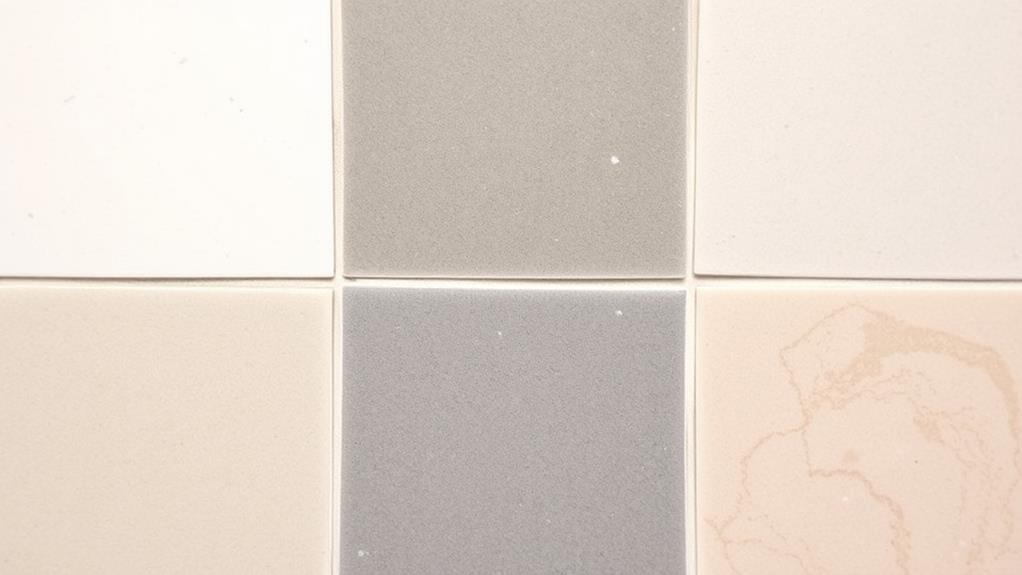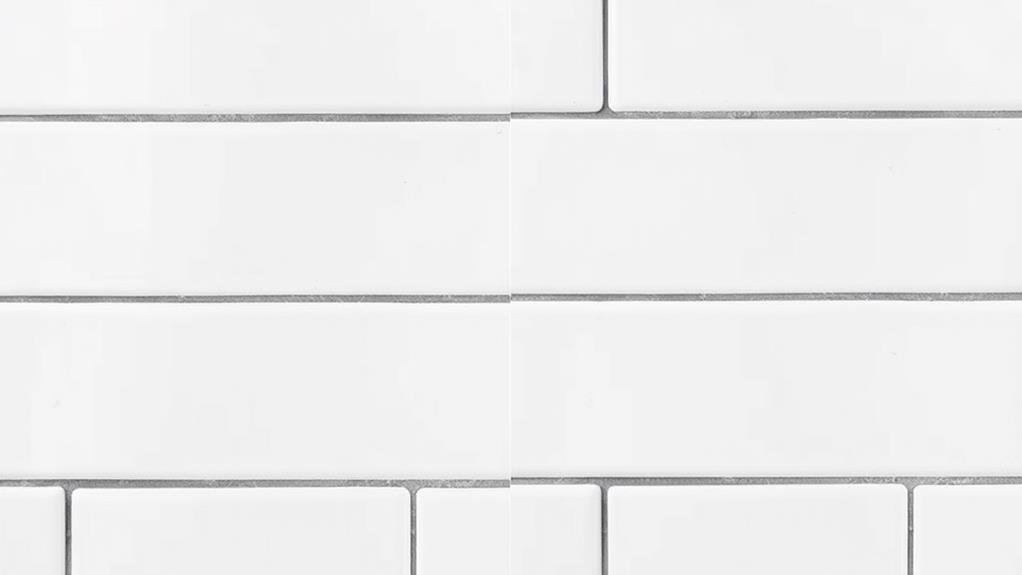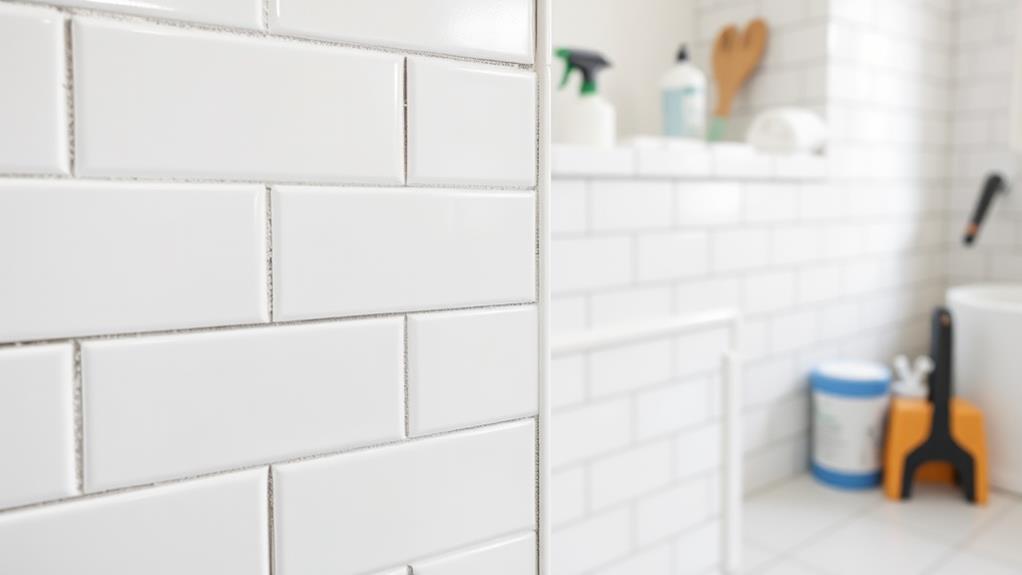When choosing grout color for your bathroom tiles, consider both aesthetics and practicality. Matching grout creates a seamless look, while contrasting grout highlights tile patterns. Light grout brightens spaces but shows dirt easily, whereas dark grout adds drama and hides stains better. Your bathroom style matters too – contemporary designs often suit bold contrasts, while traditional spaces benefit from classic white or light gray. Don't forget about maintenance; darker grouts are more forgiving and require less frequent cleaning. Popular trends include white for a crisp look, versatile grays, and striking black for contrast. The right choice can completely transform your bathroom's appearance and functionality.
Understanding Grout Color Basics

Frequently overlooked, grout color plays a crucial role in the overall appearance of your tiled bathroom. It's not just about filling gaps; grout can dramatically impact the visual effect of your tiles. Understanding the basics of grout color will help you make an informed decision for your space.
Grout comes in a wide range of colors, from classic white to bold hues and even metallic shades. The color you choose can either blend with your tiles for a seamless look or contrast them to create a striking pattern. Light-colored grout tends to brighten a space and highlight individual tiles, while darker grout can add depth and hide stains more effectively.
Consider the size of your tiles and the overall style of your bathroom when selecting grout color. Wider grout lines will make the color more prominent, so choose carefully. Remember that grout color can affect the perceived size of your bathroom; lighter shades can make a small space feel larger, while darker tones may have a cozier effect.
Don't forget about maintenance. Lighter grouts may show dirt more easily, requiring more frequent cleaning. Ultimately, your grout color choice should complement your tiles and align with your design vision.
Matching vs. Contrasting Approaches
When it comes to selecting grout color, you'll face two main approaches: matching or contrasting with your tiles. Matching grout creates a seamless, unified look that makes your bathroom appear larger and more cohesive. It's an excellent choice for small spaces or when you want to showcase intricate tile patterns. To match effectively, choose a grout color that's slightly lighter or darker than your tiles to avoid a washed-out appearance.
Contrasting grout, on the other hand, adds visual interest and highlights your tile layout. It's ideal for emphasizing unique tile shapes or creating a bold, graphic look. Light grout with dark tiles can brighten a space, while dark grout with light tiles adds drama and definition. However, be cautious with high-contrast combinations, as they can overwhelm small bathrooms or compete with other design elements.
Consider your overall bathroom style when deciding between matching and contrasting approaches. Modern, minimalist designs often benefit from matching grout, while eclectic or vintage-inspired spaces can shine with contrasting choices. Don't forget to factor in maintenance; lighter grout shows dirt more easily, while darker grout may fade over time. Ultimately, choose the approach that best complements your tiles and enhances your bathroom's aesthetic.
Impact on Tile Appearance

Selecting the right grout color can dramatically alter your tile's appearance. When you choose a grout color that closely matches your tiles, it creates a seamless, unified look that makes the individual tiles less noticeable. This approach can make your bathroom appear larger and more open, as the grout lines blend into the background.
On the other hand, opting for a contrasting grout color will highlight the shape and pattern of your tiles. This can be particularly effective if you've chosen uniquely shaped tiles or want to emphasize a specific layout. Dark grout against light tiles can create a bold, graphic effect, while light grout with dark tiles can brighten up the space and draw attention to the tile design.
Consider how different grout colors might affect the perceived size of your tiles. Matching grout can make tiles appear larger, while contrasting grout can make them seem smaller. Additionally, think about how the grout color might impact the overall mood of your bathroom. Lighter grouts tend to create a cleaner, more spacious feel, while darker grouts can add depth and drama to the space.
Considering Bathroom Style
Your bathroom's overall style plays a crucial role in determining the ideal grout color. Consider the overall aesthetic you're aiming for, whether it's modern, traditional, rustic, or eclectic.
For contemporary bathrooms, you might opt for a sleek look with matching grout colors or a bold contrast. Traditional styles often benefit from classic white or light gray grout, especially with subway tiles.
If you're going for a rustic or farmhouse look, darker grout colors can enhance the weathered appearance and highlight tile patterns. Eclectic bathrooms offer more flexibility, allowing you to experiment with unexpected color combinations.
Don't forget to factor in your bathroom's size and lighting. Lighter grout colors can make small spaces feel larger and brighter, while darker hues can add depth and drama to larger bathrooms.
Consider your fixtures and accessories as well. The grout color should complement your faucets, shower heads, and cabinet hardware. If you have statement pieces like a clawfoot tub or unique vanity, choose a grout color that doesn't compete for attention.
Maintenance and Longevity Factors

Beyond aesthetics, maintenance and longevity should be key considerations when choosing grout color. Lighter grouts, while visually appealing, tend to show dirt and stains more easily. They'll require more frequent cleaning and may need resealing sooner than darker options. If you're not prepared for this level of upkeep, consider opting for medium to dark grout colors.
Darker grouts are more forgiving when it comes to hiding dirt and discoloration. They'll maintain their appearance longer, even in high-traffic areas. However, be aware that very dark grouts can sometimes leave a haze on light-colored tiles if not properly applied and cleaned during installation.
For optimal longevity, choose a grout that's specifically designed for bathroom use. These grouts often contain antimicrobial properties to resist mold and mildew growth. Epoxy grouts, while more expensive, offer superior stain resistance and durability compared to traditional cement-based grouts.
Consider your lifestyle and cleaning habits when making your choice. If you're willing to put in extra effort for a pristine look, lighter grouts can work. For a lower-maintenance option that still looks great years down the line, darker grouts might be your best bet.
Popular Grout Color Trends
In the world of bathroom design, grout color trends are constantly evolving. You'll find that current popular choices reflect both timeless elegance and modern aesthetics. White grout remains a classic option, offering a clean and crisp look that complements various tile colors and styles. However, you're not limited to this traditional choice.
Gray grout has gained significant popularity in recent years. It's versatile, working well with both light and dark tiles, and it's less prone to showing dirt and stains. For a bolder statement, you might consider black grout, which can create striking contrast, especially with white tiles.
If you're looking for a subtle, sophisticated touch, consider matching your grout color to your tile. This creates a seamless, monochromatic look that can make your bathroom appear larger. Alternatively, you could opt for a contrasting color to highlight your tile pattern and add visual interest.
For those who want to make a unique statement, colored grouts in blues, greens, or even metallic shades are gaining traction. These can add a fun, unexpected element to your bathroom design, allowing you to express your personality through this often-overlooked detail.
Conclusion
As you're about to choose your grout color, you might find yourself coincidentally standing in a freshly tiled bathroom. Take a moment to imagine different grout hues. You'll see how they can dramatically alter the space. Remember, there's no single "right" choice—it's about what works for your style and maintenance needs. Whether you go bold or subtle, you're now equipped to make an informed decision that'll transform your bathroom into a stunning oasis.

